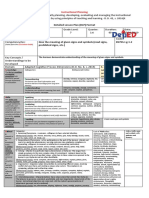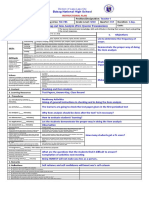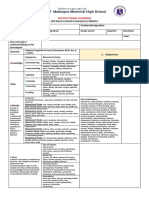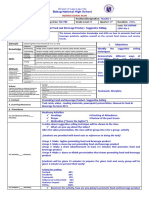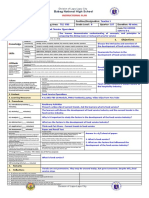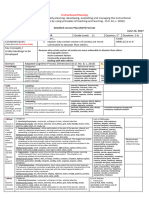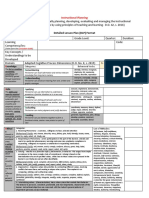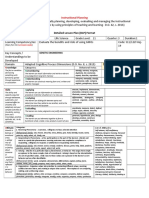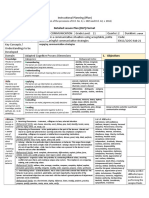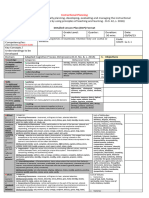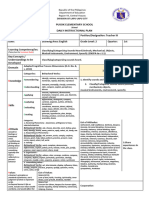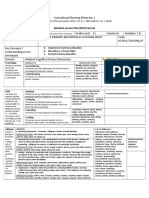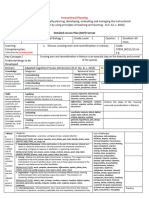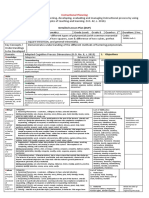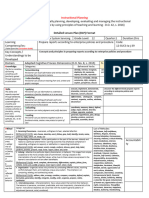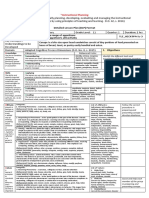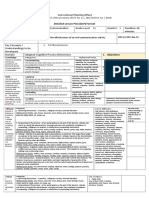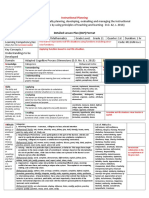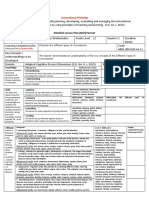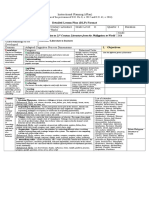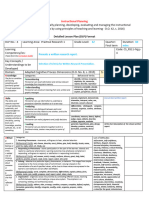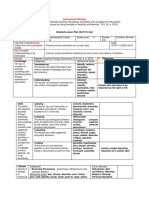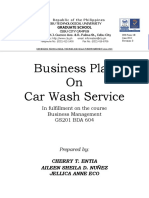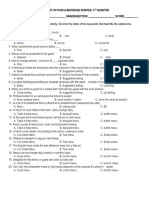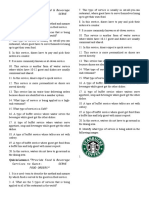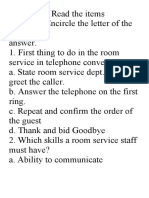Nov. 4
Nov. 4
Uploaded by
CHERRY TAGURANCopyright:
Available Formats
Nov. 4
Nov. 4
Uploaded by
CHERRY TAGURANOriginal Description:
Original Title
Copyright
Available Formats
Share this document
Did you find this document useful?
Is this content inappropriate?
Copyright:
Available Formats
Nov. 4
Nov. 4
Uploaded by
CHERRY TAGURANCopyright:
Available Formats
Division of Lapu-Lapu City
Babag National High School
INSTRUCTIONAL PLAN
Name: CHERRY T. ENTIA Position/Designation: Teacher III
Date: November 4, 2022 Learning Area: TLE- FBS Grade Level: 9 Quarter: 1ST Duration: 1 hr.
Learning Competency/ies: Compilation of activities Code:
Key Concepts / Understandings to be Developed Students shows understanding the value of compilation and record keeping.
Domain Adapted Cognitive Process Dimensions (D.O. No. 8, s. 2015)
1. Objectives
Categories: Behavioral Verbs:
Knowledge Remembering identify, retrieve, recognize, duplicate, list, memorize, repeat, describe, reproduce Discuss the requirements in the
Understanding interpret, exemplify, classify, summarize, infer, compare, explain, paraphrase, discuss computation of grades.
Applying execute, implement, demonstrate, dramatize, interpret, solve, use, illustrate, convert, discover
Analyzing differentiate, distinguish, compare, contrast, organize, outline, attribute, deconstruct
Skills Evaluating
coordinate, measure, detect, defend, judge, argue, debate, describe, critique, appraise, evaluate Generate/ work on the lacking activities.
Creating
generate, hypothesize, plan, design, develop, produce, construct, formulate, assemble, devise
Categories:
Receiving Phenomena - Awareness, willingness to hear, selected attention
Behavioral Verbs: ask, choose, describe, erect, follow, give, hold, identify, locate, name, point to, reply, select, sit, Study, use
Attitude Responding to Phenomena -
Growth in feelings or Behavioral Verbs: aid, answer, assist, comply, conform, discuss, greet, help, label, perform, practice, present, read, recite, report, select, tell, write
emotional areas.
A settled way of thinking Valuing - Display appreciation on the value of
Behavioral Verbs: work, complete, demonstrate, differentiate, explain, follow, form, initiate, invite, join, justify, propose, read, report, select, share, study
or feeling about
someone or something, Organization -
compilation.
typically one that is Behavioral Verbs: adhere, alter, arrange, combine, compare, complete, defend, explain, formulate, generalize, identify, integrate, modify, order, organize, prepare, relate,
reflected in a person’s synthesize
behavior
5. Internalizing values -
Behavioral Verbs: act, discriminate, display, influence, listen, modify, perform, practice, propose, qualify, question, revise, serve, solve, verify
List of Values:
MAKA-DIYOS
Values Love of God, Faith, Trusting, Spirituality, Inner Peace, Love of truth, Kindness, Humble
A learner's principles or standards of behavior; MAKA-TAO
Concern for Others, Respect for human rights, Gender equality, Family Solidarity, Generosity, Helping, Oneness
one's judgment of what is important in life.
Go beyond learner’s life on earth, include more
MAKAKALIKASAN
Care of the environment, Disaster Risk Management, Protection of the Environment, Responsible Consumerism, Cleanliness,
Maka-Diyos: Trusting oneself
than wealth and fame, and would affect the Orderliness, Saving the ecosystem, Environmental sustainability
eternal destiny of millions intentionally add values MAKABANSA
Peace and order, Heroism and Appreciation of Heroes, National Unity, Civic Consciousness, Social responsibility, Harmony,
to yourself and students everyday. Patriotism,
Productivity
2. Content Compilation of activities and test papers
3. Learning Resources Individual Portfolio, Activity Sheets, Answer Sheets, Table of Contents, Class Record
4. Procedures
4.1 Introductory Activity (__5__ Routinary Activities
minutes). Call students attention for students who lack activities for them to work on.
4.2 Activity (___5_ minutes). Students will work on their lacking activities
4.3 Analysis (___5_ minutes). How to compute students grades?
4.4 Abstraction (__5__ minutes). Compilation of activities is necessary in the computation of grades
4.5 Application (___30_ minutes). Let the students work on their lacking activities
4.6 Assessment (_5__ minutes). Analysis of students work performance and products.
Assessment Method Possible Activities
Observation Investigation, Role Play, Oral Presentation, Dance, Musical Performance, Skill
(Formal and informal observations of learners’ performance Demonstration, Group Activity (e.g. Choral Reading), Debate, Motor &
or behaviors are recorded, based on assessment criteria) Psychomotor Games, Simulation Activities, Science Experiment
Talking to Learners / Conferencing
(Teachers talk to and question learners about their learning Hands-on Math Activities, Written Work and Essay, Picture Analysis, Comic Strip,
to gain insights on their understanding and to progress and Panel Discussion, Interview, Think-Pair-Share, Reading Why students need to submit their outputs?
clarify their thinking)
Analysis of Learners’ Products Worksheets for all subjects, Essay, Concept Maps/Graphic Organizer, Project,
(Teachers judge the quality of products produced by learners Model, Artwork, Multi-media Presentation, Product made in technical-vocational
according to agreed criteria) subjects
d) Tests
Skill Performance Test, Open-Ended Question, Practicum, Pen and Paper Test,
(Teachers set tests or quizzes to determine learners’ ability
Pre and Post Test, Diagnostic Test, Oral Test, Quiz
to demonstrate mastery of a skill or knowledge of content)
4.7 Assignment (__2__ minutes). Fill-in below any of the four purposes:
Reinforcing / strengthening the day’s lesson
Enriching / inspiring the day’s lesson
Enhancing / improving the day’s lesson
How do you welcome or greet guest as soon they arrived?
Preparing for the new lesson
4.8 Concluding Activity (___3_ minutes) Compilation of activities is necessary for the computation of grades.
1. Remarks
2. Reflections
B. No. of learners who earned 80% in the evaluation.
C. No. of learners who require additional activities for remediation.
D. Did the remedial lessons work? No. of learners who have caught up with the lesson.
E. No. of learners who continue to require remediation.
F. Which of my learning strategies worked well? Why did these work?
G. What difficulties did I encounter which my principal or supervisor can help me solve?
H. What innovation or localized materials did I use/discover which I wish to share with other teachers?
Note: for Grade 9- LABRIGAS and 9- MISA
You might also like
- Detailed Lesson Plan (DLP) Format: Instructional PlanningDocument4 pagesDetailed Lesson Plan (DLP) Format: Instructional PlanningPapellero Villamor Glenda100% (1)
- Sample DLP 5 Organization and ManagementDocument5 pagesSample DLP 5 Organization and ManagementAileen I Reyes50% (2)
- Cot 3-Prepare AppetizersDocument5 pagesCot 3-Prepare AppetizersIvy Rosell Buayaban100% (3)
- Nov 3Document2 pagesNov 3CHERRY TAGURANNo ratings yet
- Felipe F. Matbagon Memorial High School: Detailed Lesson Plan (DLP) FormatDocument3 pagesFelipe F. Matbagon Memorial High School: Detailed Lesson Plan (DLP) FormatMeliza RollanNo ratings yet
- 3rd COTDocument2 pages3rd COTCHERRY TAGURANNo ratings yet
- Detailed Lesson Plan (DLP) Format: Instructional PlanningDocument4 pagesDetailed Lesson Plan (DLP) Format: Instructional PlanningRendyNo ratings yet
- Nail Care Lesson PlanDocument7 pagesNail Care Lesson PlanMa. Crissa Aboyme100% (1)
- IplanDocument4 pagesIplanJeraldine RepolloNo ratings yet
- DLPSTEM - BIO1112IIa J 1 2Document11 pagesDLPSTEM - BIO1112IIa J 1 2Jenn GarciaNo ratings yet
- Detailed Lesson Plan (DLP) Format: Instructional PlanningDocument4 pagesDetailed Lesson Plan (DLP) Format: Instructional PlanningZeen DeeNo ratings yet
- Detailed Lesson Plan (DLP) Format: Instructional PlanningDocument3 pagesDetailed Lesson Plan (DLP) Format: Instructional PlanningAntonio CaballeroNo ratings yet
- SeptemberDocument6 pagesSeptemberCHERRY TAGURANNo ratings yet
- OC 13 Identifies Strategies Used by Each Speaker To Convey Hisher Ideas EffectivelyDocument4 pagesOC 13 Identifies Strategies Used by Each Speaker To Convey Hisher Ideas EffectivelyZeen Dee100% (1)
- DRRR Lesson PlanDocument5 pagesDRRR Lesson PlanJenn GarciaNo ratings yet
- IPlan DLP Format English-VersionDocument5 pagesIPlan DLP Format English-VersionDina ArcenalNo ratings yet
- IPlan DLP Format v.02Document4 pagesIPlan DLP Format v.02Julie Anne MacuseNo ratings yet
- Detailed Lesson Plan (DLP) Format: Instructional PlanningDocument5 pagesDetailed Lesson Plan (DLP) Format: Instructional PlanningPapellero Villamor GlendaNo ratings yet
- Detailed Lesson Plan (DLP) Format: Instructional PlanningDocument5 pagesDetailed Lesson Plan (DLP) Format: Instructional PlanningReynalyn HernandezNo ratings yet
- Detailed Lesson Plan (DLP) Format: Instructional PlanningDocument5 pagesDetailed Lesson Plan (DLP) Format: Instructional PlanningRemedios Enad CataoNo ratings yet
- DLP FBS 1Document5 pagesDLP FBS 1Christine Rose Villanueva VargasNo ratings yet
- DLP 2Document5 pagesDLP 2Baby YanyanNo ratings yet
- Detailed Lesson Plan (DLP) Format: Instructional PlanningDocument4 pagesDetailed Lesson Plan (DLP) Format: Instructional PlanningJesson AlbaranNo ratings yet
- OC 12 The Learner Distinguishes The Types of SpeechDocument4 pagesOC 12 The Learner Distinguishes The Types of SpeechZeen DeeNo ratings yet
- C1 - Joey Jabonet-W4-Dlp1-3Document5 pagesC1 - Joey Jabonet-W4-Dlp1-3ludabelle19No ratings yet
- OC 21 Types of Communicative StrategiesDocument7 pagesOC 21 Types of Communicative StrategiesZeen Dee50% (2)
- DRRR Lesson PlanDocument4 pagesDRRR Lesson PlanJenn GarciaNo ratings yet
- CS - RS12 Id e 2Document8 pagesCS - RS12 Id e 2Josua GarciaNo ratings yet
- DLP - Iplan Template From The Region - Sir ElnarDocument4 pagesDLP - Iplan Template From The Region - Sir ElnarRhona Liza CanobasNo ratings yet
- OC 11 The Learner Distinguishes The Types of SpeechDocument4 pagesOC 11 The Learner Distinguishes The Types of SpeechZeen DeeNo ratings yet
- DRRR Lesson PlanDocument4 pagesDRRR Lesson PlanJenn GarciaNo ratings yet
- Iplan English Q1W1Document5 pagesIplan English Q1W1jesannilpenas1985No ratings yet
- OC 11.1 Ascertains The Verbal and Nonverbal Cues That Each Speaker Uses To Achieve His Her PurposeDocument4 pagesOC 11.1 Ascertains The Verbal and Nonverbal Cues That Each Speaker Uses To Achieve His Her PurposeZeen DeeNo ratings yet
- DLP - CS - RS11 IIIc e 1Document5 pagesDLP - CS - RS11 IIIc e 1joemar100% (1)
- Detailed Lesson Plan (DLP) Format: (With Inclusion of The Provisions of D.O. No. 8, S. 2015 and D.O. 42, S. 2016)Document11 pagesDetailed Lesson Plan (DLP) Format: (With Inclusion of The Provisions of D.O. No. 8, S. 2015 and D.O. 42, S. 2016)FLOREVIL BASAYNo ratings yet
- DLP - STEM - BIO1112 Id F 8Document5 pagesDLP - STEM - BIO1112 Id F 8Jenn GarciaNo ratings yet
- Detailed Lesson Plan (DLP) : Instructional PlanningDocument4 pagesDetailed Lesson Plan (DLP) : Instructional PlanningJeraldine RepolloNo ratings yet
- 10.3.3 DLP RetuyaDocument4 pages10.3.3 DLP RetuyaGlad Norman LimoconNo ratings yet
- OC 12.1 Comprehends Various Kinds of Oral TextsDocument4 pagesOC 12.1 Comprehends Various Kinds of Oral TextsZeen Dee100% (1)
- Detailed Lesson Plan (DLP) Format: Instructional PlanningDocument8 pagesDetailed Lesson Plan (DLP) Format: Instructional PlanningJulia Maria LoviteNo ratings yet
- Detailed Lesson Plan (DLP) Format: Instructional PlanningDocument5 pagesDetailed Lesson Plan (DLP) Format: Instructional PlanningEllorin RANo ratings yet
- Detailed Lesson Plan (DLP) Format: Evaluates The Effectiveness of An Oral Communication Activity EN11/12OC-Ibe-14Document4 pagesDetailed Lesson Plan (DLP) Format: Evaluates The Effectiveness of An Oral Communication Activity EN11/12OC-Ibe-14Zeen DeeNo ratings yet
- Earth & Life Science DLP 12Document4 pagesEarth & Life Science DLP 12Bowina KhoNo ratings yet
- Detailed Lesson Plan (DLP) Format: Instructional PlanningDocument9 pagesDetailed Lesson Plan (DLP) Format: Instructional PlanningJennibeth Garcia Dela RitaNo ratings yet
- Detailed Lesson Plan (DLP) Format: Instructional PlanningDocument9 pagesDetailed Lesson Plan (DLP) Format: Instructional PlanningJulia Maria LoviteNo ratings yet
- M11 GM-Ic-1Document5 pagesM11 GM-Ic-1Dan Albert AbesNo ratings yet
- OC 10 Watches and Listens To Sample Oral Communication ActivitiesDocument4 pagesOC 10 Watches and Listens To Sample Oral Communication ActivitiesZeen Dee86% (7)
- M11GM Ia 1Document5 pagesM11GM Ia 1Dan Albert Abes67% (3)
- Oral Comm 1Document7 pagesOral Comm 1Theresa B.No ratings yet
- ABM - BM11BS IIa 11Document6 pagesABM - BM11BS IIa 11Junard Asentista100% (1)
- Detailed Lesson Plan (DLP) Format: Introduction To 21 Century Literature From The Philippines To World NADocument4 pagesDetailed Lesson Plan (DLP) Format: Introduction To 21 Century Literature From The Philippines To World NAChariza PitogoNo ratings yet
- 10.2.4 DLP GealonDocument4 pages10.2.4 DLP GealonGlad Norman LimoconNo ratings yet
- Per Dev Week 2Document4 pagesPer Dev Week 2Andrey DyNo ratings yet
- Detailed Lesson Plan (DLP) Format: Instructional PlanningDocument5 pagesDetailed Lesson Plan (DLP) Format: Instructional PlanningBlessila LopezNo ratings yet
- DLP 4 CS - RS11-IVg-j-4Document5 pagesDLP 4 CS - RS11-IVg-j-4Ardint DylleNo ratings yet
- IPlan DLP Format v.02Document5 pagesIPlan DLP Format v.02Alvin Cuandot100% (1)
- Detailed Lesson Plan (DLP) Format: Instructional PlanningDocument4 pagesDetailed Lesson Plan (DLP) Format: Instructional PlanningAnonymous HJlXukJrNo ratings yet
- DLP 51Document6 pagesDLP 51Maricris Galman SalamatNo ratings yet
- Detailed Lesson Plan (DLP) Format: Instructional PlanningDocument5 pagesDetailed Lesson Plan (DLP) Format: Instructional PlanningEllorin RANo ratings yet
- Business PlanDocument12 pagesBusiness PlanCHERRY TAGURAN100% (1)
- Narrative Report - LisDocument1 pageNarrative Report - LisCHERRY TAGURAN100% (1)
- Pretest in FBS 4TH QuarterDocument2 pagesPretest in FBS 4TH QuarterCHERRY TAGURANNo ratings yet
- Quiz in Lesson 4. Types of ServiceDocument3 pagesQuiz in Lesson 4. Types of ServiceCHERRY TAGURANNo ratings yet
- QUIZ IN Lesson 3. Up SellingDocument1 pageQUIZ IN Lesson 3. Up SellingCHERRY TAGURAN100% (1)
- Lesson 1 - Room Service - 4th QuarterDocument8 pagesLesson 1 - Room Service - 4th QuarterCHERRY TAGURANNo ratings yet
